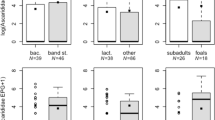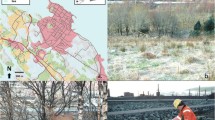Abstract
Elaphostrongylus cervi (Nematoda, Metastrongyloidea) is an extrapulmonary lungworm of red deer (Cervus elaphus) whose first-stage larvae (L1) require terrestrial gastropods as intermediate hosts. The seasonal pattern of fecal excretion of E. cervi L1 in Iberian red deer (Cervus elaphus hispanicus) was monitored during three annual periods (June 2000–May 2003) on a hunting estate from south-central Spain. The lowest rates of mean intensity of fecal L1 were found in summer, whereas no seasonal variation was found for prevalence. Monthly intensity of excretion was positively associated with early rainfall (the next month) rather than with rainfall of the same month. This seasonal rhythm of E. cervi L1 discharge may be the result of parasite adaptation to the seasonal Mediterranean climate and habitat constraints to improve the chance of parasite transmission. We have standardized the sampling period to compare E. cervi L1 infection rates of Iberian red deer populations in Mediterranean Spain, a natural limit of both the parasite and deer historical ranges, for potential use in the assessment of management strategies.

Similar content being viewed by others
References
Anderson RC (2000) Nematode parasites of vertebrates. Their development and transmission. CABI, New York
Ball MC, Lankester MW, Mahoney SP (2001) Factors affecting the distribution and transmission of Elaphostrongylus rangiferi (Protostrongylidae) in caribou (Rangifer tarandus caribou) of Newfoundland, Canada. Can J Zool 79:1265–1277
Coulson, T, Kruuk, LEB, Tavecchia, G, Pemberton JM, Clutton-Brock, TH (2003) Estimating selection on neonatal traits in red deer using elasticity path analysis. Evolution 57:2879–2892
Demiaszkiewicz A (1986) Laboratory diagnosis of protostrongylid infection in Cervidae (in Polish). Med Weter 41:660–663
Demiaszkiewicz A (1987) Epizootiolgy of Elaphostrongylus cervi infection of red deer in the Bialowieza forest (in polish). Med Weter 43:208–211
English AW, Watt CF, Corrigall W (1985) Larvae of Elaphostrongylus cervi in the red deer of Scotland. Vet Rec 116:254–256
Ezenwa VO (2004) Parasites infection rates in impala (Aepyceros melampus) in fenced game reserves in relation to reserve characteristics. Biol Conserv 118:397–401
Forrester SG, Lankester MW (1997) Extracting protostrongylid nematodes from ungulate feces. J Wildl Dis 33:511–516
Gaudernack G, Halvorsen O, Skorping A, Stokkan KA (1984) Humoral immunity and output of first-stage larvae of Elaphostrongylus rangiferi (Nematoda, Metastrongyloidea) by infected reindeer, Rangifer tarandus tarandus. J Helminthol 58:13–18
Halvorsen O, Skorping A (1982) The influence of temperature on growth and development of the nematode Elaphostrongylus rangiferi in the gastropods Arianta arbustorum and Euconulus fulvus. Oikos 38:285–290
Handeland K, Slettbakk T (1994) Outbreaks of clinical cerebrospinal elaphostrongylosis in reindeer (Rangifer tarandus tarandus) in Finmark, Norway, and their relations to climatic conditions. J Vet Med B 41:407–410
Handeland K, Gibbons LM, Skorping A (2000) Aspects of the life cycle and pathogenesis of Elaphostrongylus cervi in red deer (Cervus elaphus). J Parasitol 86:1061–1066
Kontrimavichus VL, Delyamure SL, Boev SN (1976) Metastrongyloidea of domestic and wild animals. In: Ryzhikov KM (ed) Principes of nematodology. Osnovy Nematodologii, Izdatel’stvo Nauka, Moscow
Kutzer E, Prosl H (1975) Zur Kenntnis von Elaphostrongylus cervi Cameron 1931. 1. Morphologie und Diagnose (in German). Wien Tierärztl Monatschr 62:258–266
Lankester MW (2001) Extrapulmonary lungworms of cervids. In: Samuel WM, Pybus MJ, Kocan AA (eds) Parasitic diseases of wild mammals, 2nd edn. Iowa State University, Ames
Margolis L, Esch GW, Holmes JC, Kuris AM, Schad GA (1982) The use of ecological terms in parasitology. Report of an ad hoc committee of the American Society of Parasitologists. J Parasitol 68:131–133
Martin SW, Meek AH, Willeberg P (1987) Veterinary epidemiology. Iowa State University, Ames
Mason P (1995) Elaphostrongylus cervi and its close relatives: a review of protostrongylids (Nematoda: Metastrongyloidea) with spiny-tailed larvae. Surveillance 22:19–24
Morrondo-Pelayo P, Diez-Baños P, Cabaret J (1992) Influence of desiccation of faeces on survival and infectivity of first-stage larvae of Muellerius capillaris and Neostrongylus linearis. J Helminthol 66:213–219
Nilssen AC (1997) Effect of temperature on pupal develpoment and eclosion dates in the reindeer oestrids Hypoderma tarandi and Cephenemyia trompe (Diptera: Oestridae). Physio Chel Ecol 26:296–306
Prosl H, Kutzer E (1982) Seasonal rhythm of the discharge of Dictyocaulus viviparus, Varestrongylus sagittatus and Elaphostrongylus cervi larvae from the red deer. Angew Parasitol 23:9–14
Raskevitz RF, Kocan AA, Shaw JH (1991) Gastropod availability and habitat utilization by wapiti and white-tailed deer sympatric on range enzootic for meningeal worm. J Wildl Dis 27:92–101
Rezac P (1990) Diferenciální larev. 1. Stadia hlístic Varestrongylus sagittatus a Elaphostrongylus cervi. Veterinárstvi 40:311–313
Rezac P, Palkovic L, Holasova E, Busta J (1994) Modes of entry of the first-stage larvae of Elaphostrongylus cervi (Nematoda: Protostrongylidae) into pulmonate snails Arianta arbustorum and Helix pomatia. Folia Parasitol 41:209–214
Shostak AW, Samuel WM (1984) Moisture and temperature effects on survival and infectivity of first-stage larvae of Parelaphostrongylus odocoilei and P. tenuis (Nematoda: Metastrongyloidea). J Parasitol 70:261–269
Slomke AM, Lankester MW, Peterson, WJ (1995) Infrapopulation dynamics of Paralephastrongylus tenuis in white-tailed deer. J Wildl Dis 31:125–135
Valcarcel F, Romero CG (2002). First report of Elaphostrongylus cervi in Spanish red deer Cervus elaphus hispanicus. J Helminthol 76:91–3
Vicente J, Gortazar C (2001) High prevalence of large spiny-tailed protostrongylid larvae in Iberian red deer. Vet Parasitol 96:165–70
Vicente J, Fierro Y, Martínez M, Gortazar C (2004) Long term epidemiology, effect on body condition and interspecific interactions of concomitant infection by nasopharyngeal bot fly larvae (Cephenemyia auribarbis and Pharyngomyia picta, Oestridae) in a population of Iberian red deer (Cervus elaphus hispanicus). Parasitology 129:349–361
Watson TG (1984) Tissue worm in red deer. Symptoms and control. AgLink Farm Production and Practice 249, Medi Services, Ministry of Agriculture and Food, Wellington, New Zealand
Acknowledgements
We are very grateful to the gamekeepers, especially to Bernardo Herrera for their help in the fieldwork. J. Vicente was supported by a pre-doctoral grant from Junta de Comunidades de Castilla-La Mancha. This is a contribution to FEDER-EU IFD97-0164 and CICYT AGL 2001-3947 projects, and is a result of the agreement between Yolanda Fierro and Universidad de Castilla-La Mancha.
Author information
Authors and Affiliations
Corresponding author
Rights and permissions
About this article
Cite this article
Vicente, J., Fierro, Y. & Gortazar, C. Seasonal dynamics of the fecal excretion of Elaphostrongylus cervi (Nematoda, Metastrongyloidea) first-stage larvae in Iberian red deer (Cervus elaphus hispanicus) from southern Spain. Parasitol Res 95, 60–64 (2005). https://doi.org/10.1007/s00436-004-1255-9
Received:
Accepted:
Published:
Issue Date:
DOI: https://doi.org/10.1007/s00436-004-1255-9




